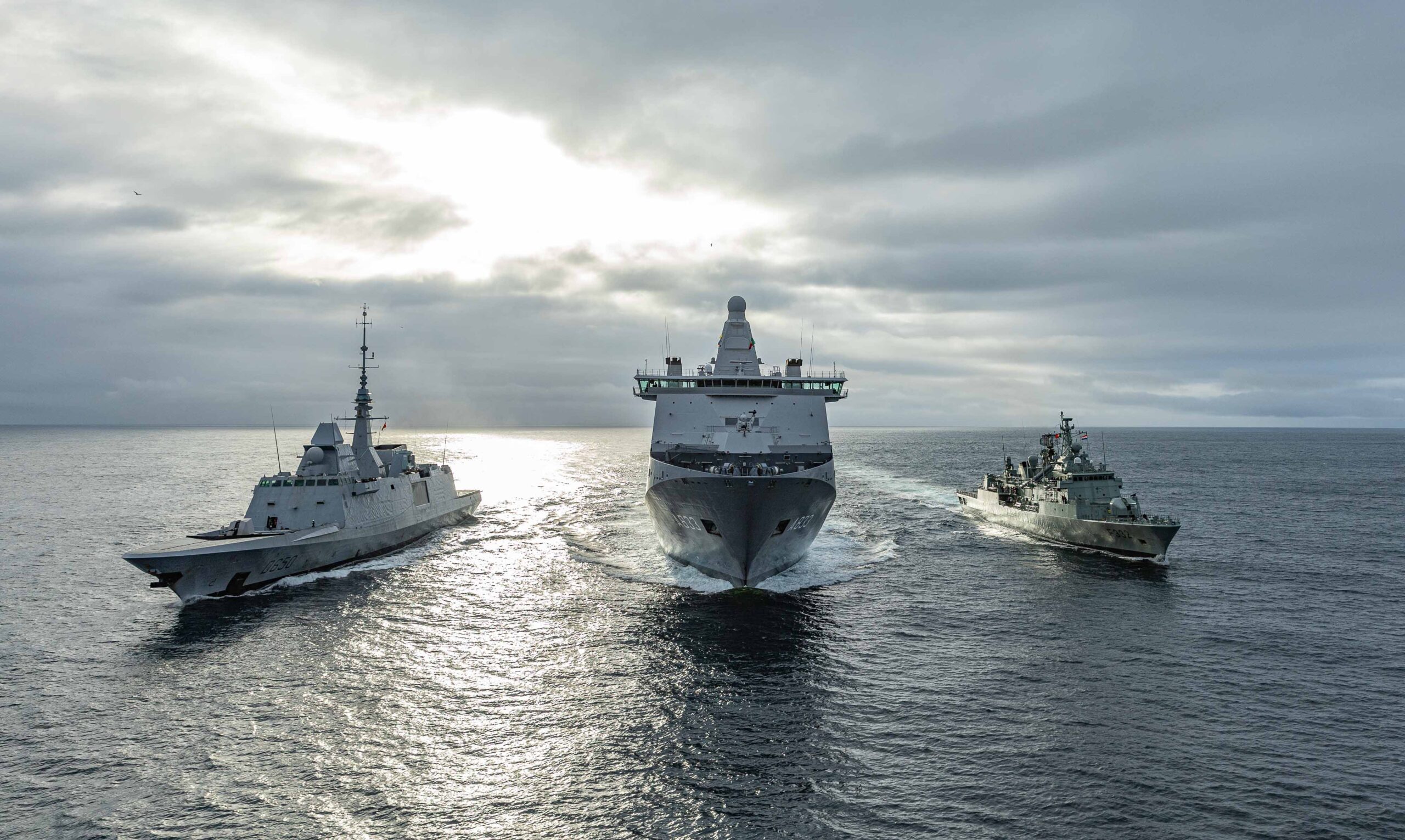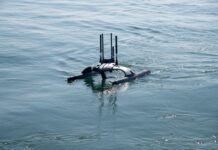The Portuguese Navy has been leading the way amongst NATO navies in developing maritime uncrewed system (MUS) technologies. Now, including at the national level, it is seeking to accelerate delivery of these systems into integrated maritime multidomain operations (MDO).

Adm de Sousa – who stepped into the Chief of Navy post at the very end of 2024, having previously been in an operational post as Deputy Chief of Staff of Portugal’s Joint Operations Command – has a combined vision consisting of maintaining and developing further the Navy’s MUS technology, while integrating this with enhanced operational development of MUS capability through concepts of operation (CONOPS) and tactical employment. The advances the Navy has made in MUS technology are now enabling the service to drive forward MUS CONOPS and tactics to match the pace of the technology change.
This position was explained to ESD by Captain Antonio Mourinha, in an interview on 16 January 2025. Capt Mourinha is Innovation Adviser to the Chief of Navy, having served until late 2024 as director of the Navy’s Centre for Naval Operational Experimentation (Centro de Experimentação Operacional da Marinha: CEOM). CEOM is headquartered in Tróia on Portugal’s southern coast, and runs the Navy’s operational experimentation (OPEX) programmes including the annual ‘REPMUS’ (‘Robotic Experimentation and Prototyping with Maritime Unmanned Systems’) multinational event, produced in partnership with NATO. The first step in delivering MUS operations was to develop the technology, to provide the tools, Capt Mourinha said: now, the focus is on bringing the use of the tools up to speed. “We will keep the speed on both sides …. The emphasis is to balance both,” he explained.
Capt Mourinha has also been appointed as the first commanding officer (CO) of the Navy’s new flagship, Dom João Segundo: due to enter service in mid-2026 and known unofficially as the ‘drone carrier’ the ship is designed to support MUS MDO. The ship illustrates the Navy’s aim of continuing MUS technology development and transitioning this technology into operational capability. It will focus on experimenting with the delivery of MUS use in maritime research, safety and security operations, command and control (C2) for MUS MDO, and tactical-level integration elements such as MUS launch and recovery and human-machine interface. “It is going to be very interesting but challenging,” said Capt Mourinha. “In terms of ship organic MUS use, this is going to be where the rubber hits the road.”
REPMUS evolution
MDO C2 was a major focus in ‘REPMUS 2024’, and will remain so in ‘REPMUS 2025’. “It is really important to keep advancing this piece of work,” said Capt Mourinha.
‘REPMUS’, held in Tróia each September, is certainly where the rubber hits the road. The exercise has become a mainstay for NATO and member state MUS capability maturation. Its long-established focus on technology development has evolved rapidly in recent years towards applying that technology at tactical and operational levels in OPEX scenarios. ‘REPMUS’ is very much an iterative process, constantly building, refining, and improving not only MUS technology and how to use it, but the process of the exercise itself in order to enhance its outputs. Lessons learned each year are fed straight into the planning process for the following year.
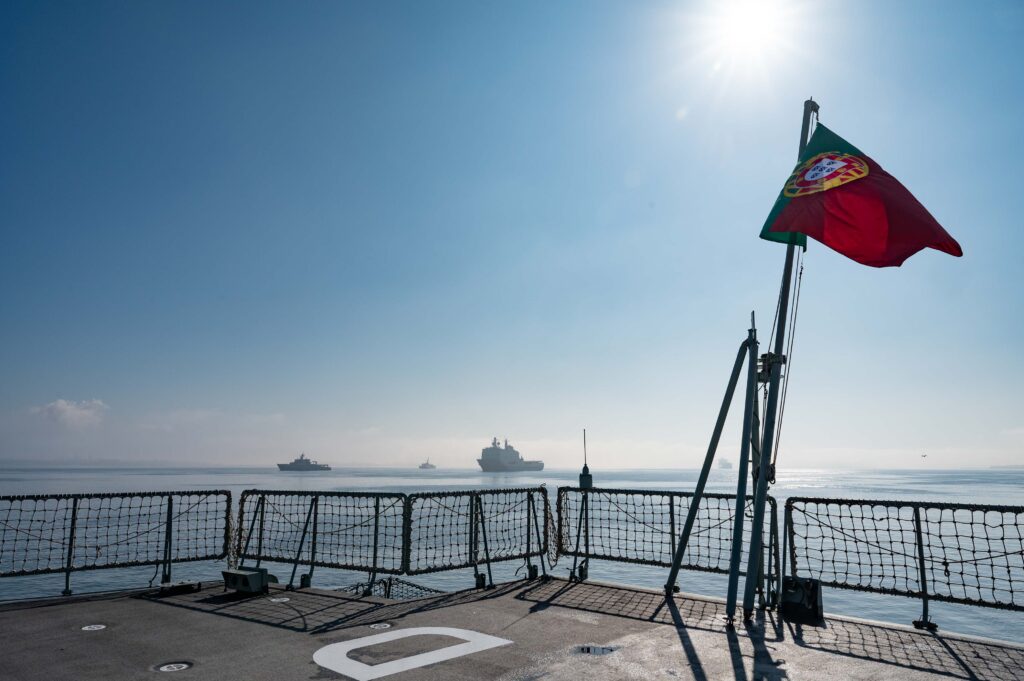
The ’virtual ship’ environment allows the Navy to test how it may conduct integrated MDO involving MUS and crewed platforms, Commander Marco Guimarães – director of the Navy’s MUS technology innovation and development cell (Célula de Experimentação Operacional de Veículos Não Tripulados: CEOV) and CO of ‘virtual ship’ Lisbon during ‘REPMUS 24’ – told ESD during a January 2025 interview. Elements tested, he explained, included running MUS MDO onboard the ship, mixing C2 activities both onboard and offboard the ship (including ashore), using different C2 systems in the same operational environment, and testing Portuguese-made MUS that may be used onboard Dom João Segundo.
Central to the testing conducted at ‘REPMUS 24’ was the first use of the Portuguese Navy-developed ‘Mission Sync’ MUS C2 architecture. NATO is developing a common standard – effectively, a technological development blueprint – for MUS C2 operations at a tactical level, including the enabling C2 architecture. This is known as Standardisation Agreement (STANAG) 4817. ‘REPMUS’ has been testing two STANAG 4817-compliant architectures – or C2 ‘languages’: the UK/US-developed I2I (Interoperability to Interchangeability); and NATO in-house research and testing laboratory the Centre for Maritime Research and Experimentation’s (CMRE’s) CATL (Collaborative Autonomy Tasking Layer). Mission Sync – created by CEOV – integrates the key features of these architectures, providing a ‘REPMUS’-wide framework that all participants can ‘plug in’ to. Thus, Capt Mourinha explained that “Mission Sync is actually the first prototype of STANAG 4817.”
Using Mission Sync “was a path that was growing and building itself during ‘REPMUS 24’”, according to Cdr Guimarães. During the exercise, some participants were unaware of the need to use (or how to use) Mission Sync, of its benefits or importance, or of the use and meaning of certain language within it, he explained. This meant Mission Sync could not be used fully across all the exercise serials, with some different C2 formats used instead.
“This … is something we kept as lessons learned from the exercise, and will try to correct on ‘REPMUS 25’,” Cdr Guimarães added. For example, some serials in ‘REPMUS 25’ will be conducted using only Mission Sync-capable or -compliant MUS, to help conduct experimentation at maximum value and to test and understand fully Mission Sync’s benefits for the serial.
“One lesson we took from ‘REPMUS 24’ is that Mission Sync is a very good tool for collecting information that can be used the following years,” said Cdr Guimarães. “This information is now organised into different categories so we can make a very good assessment of a serial and how to replicate it in the future.”

Second, Capt Mourinha continued, Mission Sync will bring new developments in information sharing. At ‘REPMUS 2023’, the MUS were able to connect into the ‘virtual ship’ network to share basic tactical data such as positioning, course, and speed. In ‘REPMUS 24’, Mission Sync was used as a common tool for sending and receiving tasking. For ‘REPMUS 25’, the aim is to add data exchange to the system’s capacity, helping for example in changing tasking orders.
Such information-sharing capacity amongst MUS systems and with crewed platforms and C2 nodes will also be used in ‘REPMUS 25’ for sharing information relating to a new doctrinal development validated in ‘REPMUS 24’. This development is called the ‘OPSTAT MUS’, Capt Mourinha explained. Routinely when a naval unit joins a task group, a message called the ‘OPSTAT Unit’ is shared with the group’s command and C2 nodes, setting out the operational status of the unit’s capabilities. An ‘OPSTAT MUS’ provides the capabilities of the MUS, including for example speed, range, and payload. “So, at ‘REPMUS 25’, the ‘OPSTAT MUS’ will flow using Mission Sync. This is also a big advance,” said Capt Mourinha.
With Mission Sync, Capt Mourinha continued, “We are moving at pace to create a really important interoperability tool to conduct multi-domain MUS C2.” “[It will help provide] the right information to the decision-maker in order to conduct the operation,” Cdr Guimarães added.
High-end impact
Alongside continuing to develop the architecture underpinning MUS capability development and operational use, ‘REPMUS 24’ also took key steps regarding operational concepts MUS capability can support. Here, Capt Mourinha underscored some important capability developments in the underwater battlespace. “We did a lot of experimentation in the underwater battlespace, and we advanced in mine warfare, anti-submarine warfare [ASW], and critical undersea infrastructure [CUI] protection,” he said. The mine warfare side saw improvements in tactical development and standardisation terms.
On ASW, ‘REPMUS’ is a major testing ground for NATO’s ASW Barrier concept, which is designed to develop MUS capability for conducting bi- and multi-static sonar sensing for submarine detection. ‘REPMUS 24’ therefore presented an opportunity to mix ASW Barrier developments with another current NATO focus area – counter-UxV technologies and operations. “For the first time, we created a barrier [providing] detection capability for uncrewed underwater vehicles [UUVs],” said Capt Mourinha. “So, instead of only using the ASW Barrier as a barrier for submarines, we tested a more detailed and more complex construct where we set up a small barrier for UUV detection that could be used in harbour security, force protection, or other contexts.”
Another ‘first’ was conducted in the CUI domain. “For the first time, we did deep-sea CUI protection,” said Capt Mourinha. Shallow-water CUI serials were conducted in ‘REPMUS 23’: at ‘REPMUS 24’, serials were conducted at depths beyond 600 m. “We tried to monitor and protect an undersea cable at that depth. We had some successes, some failures, but again we learned a lot,” he said.
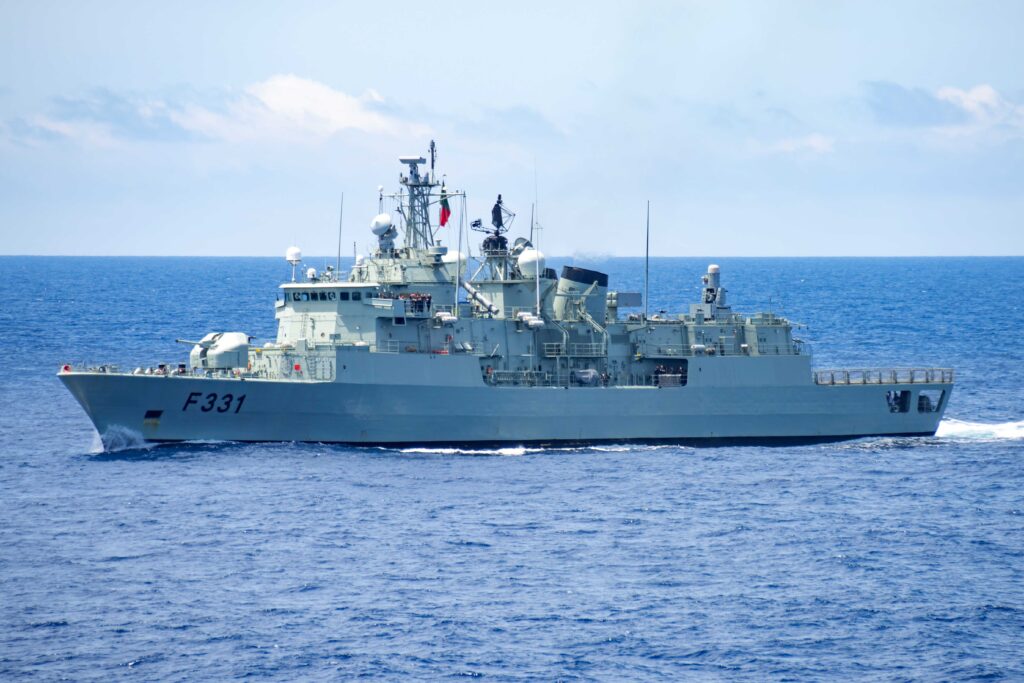
Indeed, Portugal is looking to use CEOM, a government-established ‘free tech zone’ testing area covering large parts of the region around Tróia, and the broader ‘REPMUS’ testing construct to generate more regular technology testing opportunities across the year. Navies are looking to tap into the Tróia-centred testing network more regularly throughout the year, including the UK Royal Navy and the US Navy – the latter, with its US Sixth Fleet-based ‘Task Force 66’, which drives innovation in asymmetric capabilities to support allies and partners across the European and African theatres. Portugual’s defence industry is also looking to exploit this testing capacity, for example developing regular, ‘mini-REPMUS’-style events with the Portuguese Navy.
In the time between ‘REPMUS 24’ and ‘REPMUS 25’, delivery will be completed of a new uncrewed surface vessel (USV) that will be central to the Navy’s MUS testing and operations. The Trator do Mar (Sea Tractor) USV is fitted with a towed array sonar system to conduct grid-search pattern-based surveillance (this pattern can be thought of akin to a farming tractor ploughing a field).
“We are full steam ahead with Trator Do Mar,” said Cdr Guimarães. The first USV was tested at ‘REPMUS 24’. Further at-sea testing was conducted with these USVs in early 2025. By the end of March 2025, the Portuguese Navy is set to have received all four of an initial procurement batch. The new fleet will be readied to contribute to experimentation and serials at ‘REPMUS 25’, Cdr Guimarães added.
While the Trator do Mar USVs were delivered initially to CEOV, in 2025 the USVs – plus various UAVs – will be transferred to the Portuguese Navy’s X31 squadron to add operational capacity, Capt Mourinha explained. X31 – which reports administratively to CEOM, and operationally to the Navy’s Fleet Commander – is responsible for integrating the Navy’s various MUS capabilities under a single operational unit. For Trator do Mar, Capt Mourinha said “X31 needs to develop the ability to use this.”
Experimentation to operation
For the Portuguese Navy, CEOM and CEOV are two of three centres used for conducting experimentation and testing of naval capability including MUS. The third is the Navy’s tactical operations centre, CITAN. Just as CEOV develops the new technology, so CITAN will develop tactics, techniques, and procedures (TTPs) for using the new capability. Covering both organisations, CEOM then conducts certification and delivery of the technology and TTPs to the operational community.
“That’s the way we are going to evolve our capabilities from now on,” said Capt Mourinha. For MUS, “X31 will be the receiver for both the new equipment and the new TTPs.” “X31 will be integrating these with the manned assets, including to build manned/unmanned teaming [M/UMT] concepts and constructs, using both organic and non-organic uncrewed systems,” he added. “X31 is quite a small unit, but very powerful in the sense that they are delivering the operational effects and demonstrating the usefulness of uncrewed capabilities,” Capt Mourinha continued.
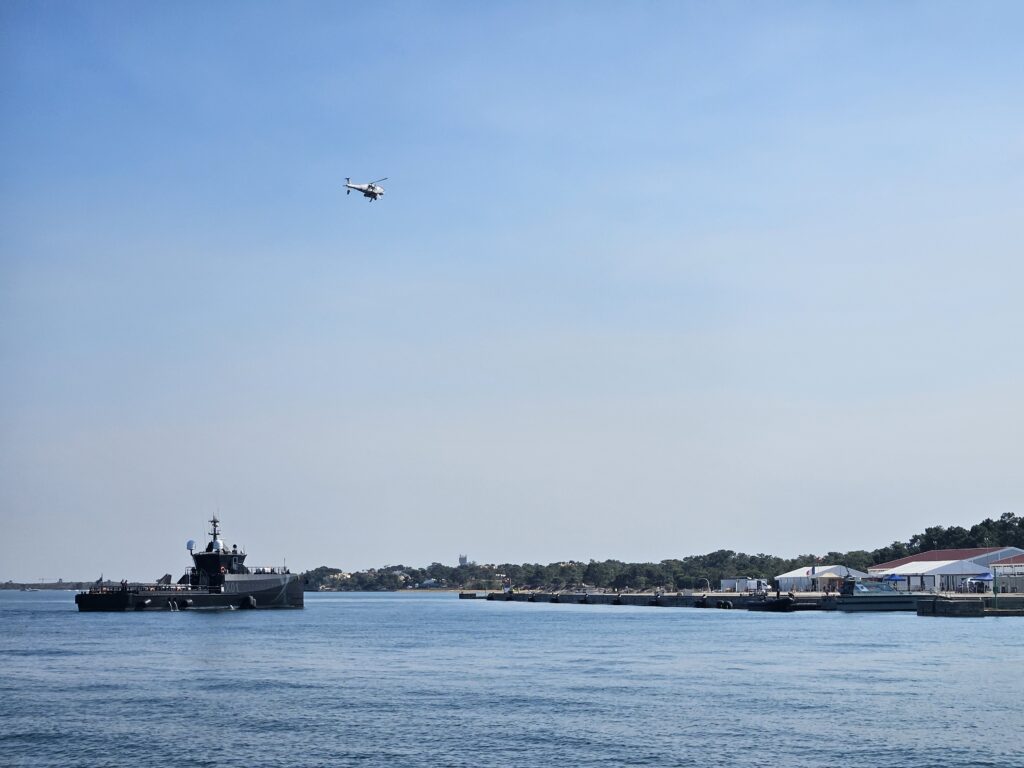
Starting in 2025, the next steps for X31 include developing an MDO operational concept. Alongside using UAVs, Capt Mourinha explained, “X31 needs now to move to the operation of USVs and UUVs, all at the same time if possible.” MUS multi-domain integration is something the Navy intends to demonstrate at ‘REPMUS 25’, harnessing CEOM’s establishment there of a ‘virtual bridge’ for Dom João Segundo. X31 will need to be present to conduct integrated MUS MDO with the ship’s emerging crew. X31 also will be extensively involved in developing Mission Sync, including use in real operations for MUS C2. For CEOV, it supports X31 with MUS integration onboard ships, as well as X31’s at-sea operation of such systems. Here, the Navy is joining legacy platforms and new systems to conduct integrated operations in the form of M/UMT.
“We will try different technologies and different communications systems integration not only with the assets, but between X31 vehicles and the organic platform, to make progress in having more assets that are organic to the ships, or that can be deployed and retrieved from onboard the ships, to reinforce MUS use onboard the ships we already have,” said Cdr Guimarães.
Capt Mourinha and Cdr Guimarães both noted that 2025 will be a busy period in the Navy’s MUS development, with important hurdles to clear. Yet clearing these hurdles will help deliver integrated operational output. “2025 will be the year we come from the laboratory to be onboard the vessels, to deliver effect onboard our ships,” said Cdr Guimarães.
Delivering a new capability like MUS, and then integrating such a novel concept into MDO and M/UMT, is challenging. However, for the Navy, the operational benefits are clear. “It’s complicated, but that’s the reason we need to do it. We cannot run away from complicated things,” said Capt Mourinha. “We need to sort it out, we need to do it well, because the wars of today and the wars of the future are complex”, he added, “We need to be able to [operate] within a complex environment and complex C2 structure, to not be confused, to deliver properly, and to get advantage.”
Dr Lee Willett

